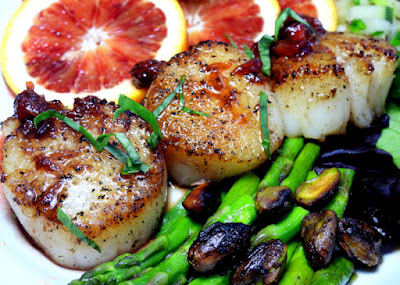Today, I’m taking my favorite bivalve mollusks – sea scallops
- and pan-searing them in a combination of butter and oil and then accenting
them with a basic gastrique sauce. A
gastrique is simply a sweet and sour sauce, starring some sort of fruit (or
fruits), tweaked with sugar, and balanced out with a vinegar. I’m using strawberries and blood oranges for
the fruits and a good quality balsamic vinegar for the tartness to complement.
The scallops are only going to take a few minutes to
cook, so it’s important to have any side dishes prepared and ready to
serve. I have a few suggestions for
accompaniments - asparagus and pistachios, a simple condiment of diced
cucumbers and red onions, accented with fresh basil, and also wild rice
enhanced with orange zest to subtly echo the orange in the gastrique.
Let’s start with making the gastrique. As I said, a gastrique is a sweet and sour
sauce, slightly thickened, with the sweetness typically coming from fruit and
sugar and the sour from vinegar. The
beauty of a gastrique is in its versatility – you can experiment with different
fruits and vinegars and create limitless flavor variations to pair with all
types of meats – from delicate seafoods and chicken to more robust meats like
pork and beef. For my gastrique to
complement the scallops, I’m using strawberries and blood oranges for my fruits
along with a balsamic vinegar. Balsamic
vinegars can vary in quality and price and some are even labeled “balsamic” but aren’t true balsamic
vinegars. Don’t go with a cheap,
knock-off balsamic vinegar, which would be comparable to using “Parmesan” from
the green can instead of a true Parmegiano Reggiano cheese. When looking for a good balsamic vinegar, you
might want to visit a market that lets you taste test before buying.
Rosie Note: Authentic balsamic vinegars are made from
grapes harvested only in the Reggio Emilia or Modena regions of Italy. The production of traditional balsamic
vinegars is tightly defined and highly regulated, the entirety of which is overseen
from beginning to end by a special certification committee, so these vinegars
can be quite expensive. They are marked
with a DOP stamp (Denominazione di
Origine Protetta or protected designation of origin) which guarantees the
ingredient’s quality, production, and place of origin. A balsamic vinegar with a DOP stamp is too
expensive and not necessary for a gastrique.
This is more of a “tasting” vinegar.
What I look for is a balsamic vinegar with an IGP stamp (indicazione geographic protetta or
protected geographical indication). It
indicates the product is not as stringently regulated as the DOP vinegars, but
is still a high-quality vinegar, having undergone a controlled standard of
production.
For the gastrique:
zest and juice of 1 blood orange
½ cup strawberries, chopped
2 TB sugar
2 TB balsamic vinegar
Freshly ground pepper
Combine all ingredients except pepper in a small saucepan
and heat over very low heat until reduced to almost half and thickened. Remove from heat and season with pepper, to
taste.
For the cucumber
salad:
¼ cup diced cucumber
¼ cup chopped red onion
¼ cup peeled, seeded, and diced tomato, if desired
2 tsp sugar
1 TB cider vinegar
1-2 basil leaves, chopped
Kosher salt and freshly ground pepper, to taste
Combine all ingredients.
Cover and chill for at least 30 minutes. Taste test before serving.

For the asparagus
and pistachios:
Heat skillet over medium high heat with butter. When foamy, add in the pistachios and cook,
stirring, until slightly browned. Add in
the asparagus spears (cut into halves or thirds) and pour in about ¼ cup water
and let it steam off, cooking about 30
seconds. Remove asparagus and
pistachios. Asparagus should be al dente, firm but crisp-tender.
For the wild rice:
I used a white, brown, red, and wild rice blend. Cook 1 cup rice according to directions. Stir in 2 TB unsalted butter and a tablespoon
or more of orange zest.
For the scallops:
I’m using large ocean scallops, not the smaller bay
scallops.

To prepare the scallops, first remove that tough side muscle on the
scallops. It’s a rectangular tag with
the muscle fibers running opposite the fibers in the scallop and you can just
pinch it off. Feed it to your cat or
discard. Next, rinse scallops under
cool, running water and pat thoroughly dry with paper towels. Season with a few twists of freshly ground
pepper.
When searing a delicate seafood like scallops, I
use both butter and oil in a hot pan.
The butter is for flavor and the oil is to raise the smoke point so the
milk solids in the butter don’t burn.
Heat a heavy skillet with a tablespoon each of oil and
unsalted butter to 375°.

Add scallops one at a time, placing at least an inch apart
from each other. Do NOT crowd the
pan. Usually, you’ll need to cook the
scallops in batches, giving the oil and butter time to come back to temperature
in between. Cook about 90 seconds on the
first side, turn the scallops over, and cook for about 45 seconds on the second
side. Remove from pan.
To serve:
Pour a small pool of the gastrique and place scallops in
the sauce. You can drizzle a little of
the gastrique over top if you like. You
might want to chiffonade some basil to sprinkle over the scallops. (Chiffonade is simply a cutting
technique. Stack your basil leaves, roll
them tightly lengthwise, and thinly slice perpendicular to the roll.) I also like to add sliced oranges and strawberries
on the plate to allude to the flavors in the gastrique. Serve with asparagus, wild rice, cucumber
salad, and mixed salad greens.

Enjoy!








































